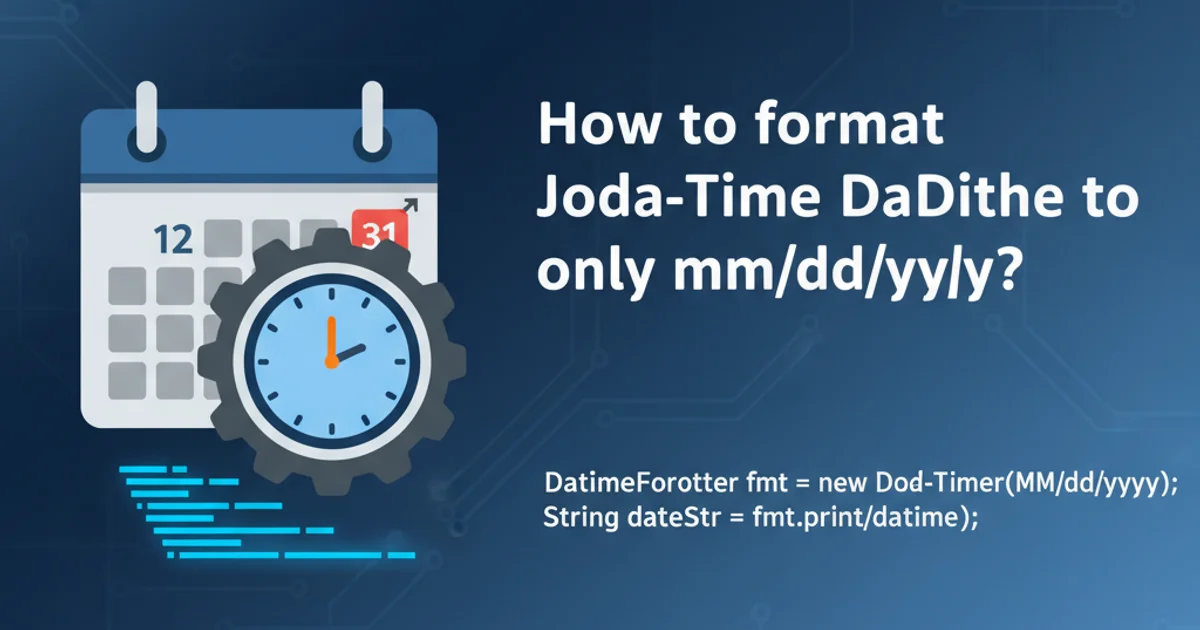How to format Joda-Time DateTime to only mm/dd/yyyy?
Categories:
Formatting Joda-Time DateTime to mm/dd/yyyy

Learn how to precisely format Joda-Time DateTime objects into the common mm/dd/yyyy string representation using various formatters and patterns.
Joda-Time, while now largely superseded by the java.time package in Java 8 and later, remains prevalent in many legacy applications. When working with Joda-Time DateTime objects, a common requirement is to format them into a specific string pattern, such as mm/dd/yyyy. This article will guide you through the process using Joda-Time's powerful formatting capabilities.
Understanding Joda-Time Formatters
Joda-Time provides robust classes for date and time formatting, primarily DateTimeFormatter and ISODateTimeFormat. For custom patterns like mm/dd/yyyy, DateTimeFormatter is the go-to choice. It allows you to define a pattern string that dictates how the DateTime object should be rendered as text.
flowchart TD
A[Joda-Time DateTime Object] --> B{Create DateTimeFormatter}
B --> C["Define Pattern: 'MM/dd/yyyy'"]
C --> D[Call formatter.print(dateTime)]
D --> E[Formatted String: 'mm/dd/yyyy']Process for formatting Joda-Time DateTime
Basic Formatting with DateTimeFormatter
The most straightforward way to achieve the mm/dd/yyyy format is by creating a DateTimeFormatter instance with the desired pattern. Remember that 'MM' represents the month (01-12), 'dd' represents the day of the month (01-31), and 'yyyy' represents the year (e.g., 2023). Using lowercase 'mm' would represent minutes, which is not what we want for months.
import org.joda.time.DateTime;
import org.joda.time.format.DateTimeFormat;
import org.joda.time.format.DateTimeFormatter;
public class JodaTimeFormatter {
public static void main(String[] args) {
// 1. Create a DateTime object (e.g., current date and time)
DateTime now = new DateTime();
System.out.println("Original DateTime: " + now);
// 2. Define the desired format pattern
String pattern = "MM/dd/yyyy";
// 3. Create a DateTimeFormatter using the pattern
DateTimeFormatter formatter = DateTimeFormat.forPattern(pattern);
// 4. Format the DateTime object to a string
String formattedDate = formatter.print(now);
System.out.println("Formatted Date (MM/dd/yyyy): " + formattedDate);
// Example with a specific date
DateTime specificDate = new DateTime(2023, 10, 26, 15, 30, 0);
String formattedSpecificDate = formatter.print(specificDate);
System.out.println("Formatted Specific Date: " + formattedSpecificDate);
}
}
Example of formatting Joda-Time DateTime to 'MM/dd/yyyy'.
Handling Time Zones (Optional but Recommended)
While the mm/dd/yyyy format doesn't explicitly include time zone information, the DateTime object itself is time zone-aware. When formatting, the date components will reflect the DateTime object's internal time zone. If you need to ensure the date is formatted according to a specific time zone, you can apply a withZone() method to your formatter or DateTime object.
import org.joda.time.DateTime;
import org.joda.time.DateTimeZone;
import org.joda.time.format.DateTimeFormat;
import org.joda.time.format.DateTimeFormatter;
public class JodaTimeZoneFormatter {
public static void main(String[] args) {
DateTime utcNow = new DateTime(DateTimeZone.UTC);
System.out.println("UTC DateTime: " + utcNow);
String pattern = "MM/dd/yyyy";
DateTimeFormatter formatter = DateTimeFormat.forPattern(pattern);
// Format in UTC (default for utcNow)
String formattedUtc = formatter.print(utcNow);
System.out.println("Formatted UTC Date: " + formattedUtc);
// Format in a specific time zone (e.g., New York)
DateTimeFormatter nyFormatter = formatter.withZone(DateTimeZone.forID("America/New_York"));
String formattedNy = nyFormatter.print(utcNow);
System.out.println("Formatted New York Date: " + formattedNy);
// Or change the DateTime object's zone before printing
DateTime nyDateTime = utcNow.withZone(DateTimeZone.forID("America/New_York"));
String formattedNyFromDateTime = formatter.print(nyDateTime);
System.out.println("Formatted New York Date (from DateTime): " + formattedNyFromDateTime);
}
}
Formatting a Joda-Time DateTime with specific time zones.
java.time (the Date and Time API) as Joda-Time is now in maintenance mode. The java.time.format.DateTimeFormatter works similarly.Summary of Formatting Steps
To recap, formatting a Joda-Time DateTime object to MM/dd/yyyy involves a few clear steps. This approach ensures consistency and correctness in your date representations.
1. Instantiate DateTime
Obtain or create a org.joda.time.DateTime object that you wish to format.
2. Define Pattern String
Create a string variable for your desired format pattern, e.g., "MM/dd/yyyy".
3. Create Formatter
Use DateTimeFormat.forPattern(pattern) to get a DateTimeFormatter instance.
4. Print to String
Call the formatter.print(dateTimeObject) method to get the formatted string.
5. Consider Time Zone (Optional)
If necessary, use formatter.withZone(DateTimeZone.forID("...")) or dateTimeObject.withZone(...) to handle specific time zone requirements before formatting.